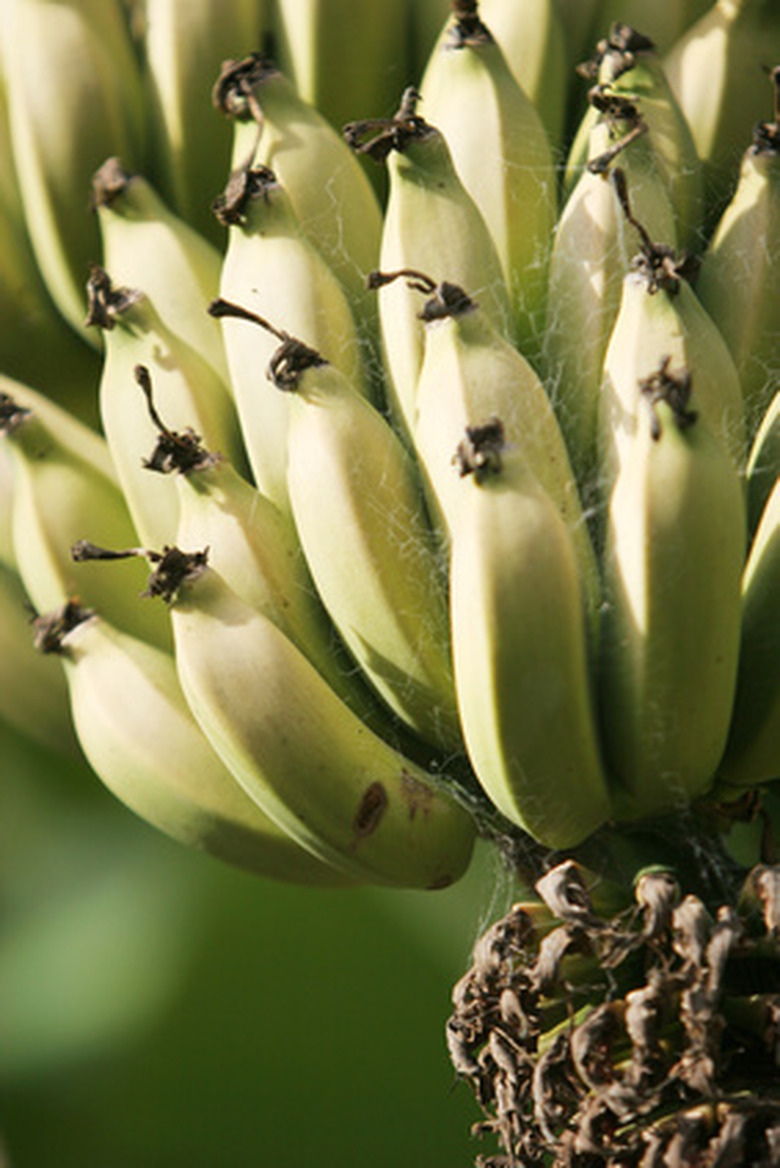Dwarf Cavendish Banana Tree Care
Considered among the shortest growing varieties, Dwarf Cavendish banana tree (Musa 'Dwarf Cavendish') will grow up to 6 to 10 feet tall with wide-reaching leaves. If summers are long and warm, a stem may produce a hand of fruits. It often grows as a seasonal tropical foliage ornamental in cold winter regions. Grow it outdoors in the ground in U.S. Department of Agriculture hardiness zones 8 and warmer; frost kills the plant back to the underground roots.
Light
Provide as much sun as possible for the Dwarf Cavendish banana, ideally no less than 8 to 10 hours of direct sunshine daily. If shorter plants or just foliage is desired without fruits, more shade is acceptable.
Warmth
All bananas relish warm soil and air temperatures. For lush growth and development of flowers and subsequent fruit, plant this variety where temperatures are `above 80 degrees for at least six to nine months. Flowers and immature fruit hands may develop at the end of summer but will not mature if temperature drop below 80 degrees in autumn. Frosts kill above-ground foliage to the ground. Extended subfreezing temperatures below 22 degrees kill underground roots.
- Considered among the shortest growing varieties, Dwarf Cavendish banana tree (Musa 'Dwarf Cavendish') will grow up to 6 to 10 feet tall with wide-reaching leaves.
- For lush growth and development of flowers and subsequent fruit, plant this variety where temperatures are `above 80 degrees for at least six to nine months.
Soil
Provide the tree with an organic-rich, moist but well-draining soil that is deep and warm. The California Rare Fruit Growers Association recommends planting bananas directly into a well-rotted compost pile. Sandy soils are easiest to cultivate, but clay soils work as long as they are porous, fertile and contain large quantities of compost or manure.
Watering
In the heat of the growing season, ensure the soil is always moist. Do not over-water so that the roots remain in soggy, which leads to root rot or suffocation especially in cool weather. Provide 1 to 2 inches of rainfall or irrigation to the banana's root system every two to three days when temperatures are above 80 degrees, even more frequently if above 90 degrees. In cooler weather, monitor the soil and irrigate only when soil becomes slightly dry. When dormant or in winter, keep soil barely moist; wet soils in cold weather leads to root rot and plant demise.
- Provide the tree with an organic-rich, moist but well-draining soil that is deep and warm.
- In cooler weather, monitor the soil and irrigate only when soil becomes slightly dry.
Fertilizing
In the heat of summer, repeatedly apply new amounts of well-rotted compost or manure as a mulch around the Dwarf Cavendish's root zone. Occasional fertilizer feeding and watering with a well-balanced water soluble fertilizer works well. Granular fertilizers also supplement the compost and liquid feedings. Follow product label directions for dosage. Do not fertilize in fall or winter when the plant is waning or dormant.
Upkeep
Once a banana stalk flowers and fruits, it is destined to die. Remove the fruit hands when ready to eat and then cut down that entire stalk with a machete or pruning saw. This allows the smaller pup plants emerging from the roots to replace it. If a winter frost kills foliage, do not prune away materials until spring when there is no further threat of frost. The dead leaves and stalks help protect the roots from further freezes or cold. Thin large root clumps every three to five years and divide them and replant to reinvigorate plants and to increase plant numbers. Do this in mid-spring or at the start of the tropical rainy season.
- In the heat of summer, repeatedly apply new amounts of well-rotted compost or manure as a mulch around the Dwarf Cavendish's root zone.
